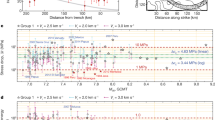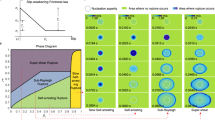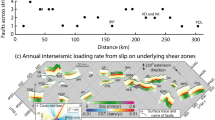Abstract
There is growing evidence that some proportion of large and great earthquakes are preceded by a period of accelerating seismic activity of moderate-sized earthquakes. These moderate earthquakes occur during the years to decades prior to the occurrence of the large or great event and over a region larger than its rupture zone. The size of the region in which these moderate earthquakes occur scales with the size of the ensuing mainshock, at least in continental regions. A number of numerical simulation studies of faults and fault systems also exhibit similar behavior. The combined observational and simulation evidence suggests that the period of increased moment release in moderate earthquakes signals the establishment of long wavelength correlations in the regional stress field. The central hypothesis in the critical point model for regional seismicity is that it is only during these time periods that a region of the earth’s crust is truly in or near a “self-organized critical” (SOC) state, such that small earthquakes are capable of cascading into much larger events. The occurrence of a large or great earthquake appears to dissipate a sufficient proportion of the accumulated regional strain to destroy these long wavelength stress correlations and bring the region out of a SOC state. Continued tectonic strain accumulation and stress transfer during smaller earthquakes eventually re-establishes the long wavelength stress correlations that allow for the occurrence of larger events. These increases in activity occur over longer periods and larger regions than quiescence, which is usually observed within the rupture zone of a coming large event. The two phenomena appear to have different physical bases and are not incompatible with one another.
Access this chapter
Tax calculation will be finalised at checkout
Purchases are for personal use only
Preview
Unable to display preview. Download preview PDF.
Similar content being viewed by others
References
Australian Geological Survey Organization (1996), Monthly Report On Australian Earthquakes 96/5A.
Ben-Zion, Y. (1996), Stress, Slip, and Earthquakes in Models of Complex Single fault Systems Incorporating Brittle and Creep Deformations, J. Geophys. Res. 101, 5677–5706.
Bowman, J. R. (1992), The 1988 Tennant Creek, Northern Territory, Earthquakes: A Synthesis, Aust. J. Earth Sci. 39, 651–699.
Bowman, D. D., Ouillon, G., Sammis, C. G., Sornette, D., and Sornette, A. (1998), An Observational Test of the Critical Earthquake Concept, J. Geophys. Res. 103, 24,359–24,372.
Brehm, D. J., and Braile, L. W. (1998), Intermediate-term Prediction Using Precursory Events in the New Madrid Seismic Zone, Bull. Seismol. Soc. Am. 88, 564–580.
Bufe, C. G., and Varnes, D. J. (1993), Predictive Modeling of the Seismic Cycle in the Greater San Francisco Bay Region, J. Geophys. Res. 98, 9871–9983.
Bufe, C. G., Jaumé, S. C., Nishenko, S. P., Sykes, L. R., and Varnes, D. J. (1990), Accelerating Moment Release in the Alaska Subduction Zone: Precursor to a Great Thrust Earthquake? (Abstract), EOS, Trans. AGU 71, 1451–1452.
Bufe, C. G., Nishenko, S. P., and Varnes, D. J. (1992), Clustering and Potential for Large Earthquakes in the Alaska-Aleutian Region (Extended Abstract), Proc. Wadati Conf. on Great Subduction Earthquakes, University of Alaska, 129–132.
Bufe, C. G., Varnes, D. J., and Nishenko, S. P. (1993), A Nonlinear Time-and Slip predictable Model for Foreshocks (Abstract) EOS, Trans. AGU 1993 Fall Meeting Suppl. 74, 437.
Bufe, C. G., Nishenko, S. P., and Varnes, D. J. (1994a), Seismicity Trends and Potential for Large Earthquakes in the Alaska-Aleutian Region, Pure appl. geophys. 142, 83–99.
Bufe, C. G., Varnes, D. J., and Nishenko, S. P. (1994b), Long-term Seismicity Patterns and Pre-earthquake Failure Processes (Abstract) EOS, Trans. AGU 1994 Fall Meeting Suppl. 75, 434.
Bufe, C. G., Varnes, D. J., and Nishenko, S. P. (1996), Time-to-failure in the Alaska-Aleutian Region: An Update (Abstract), EOS, Trans. AGU, 1996, Fall Meeting Suppl. 77, F456.
Das, S., and Kostrov, B. V. (1990), Inversion for Seismic Slip Rate History and Distribution with Stabilizing Constraints: Application to the 1986 Andreanof Islands Earthquake, J. Geophys. Res. 95, 6899–6913.
Deng, J., and Sykes, L. R. (1997), Evolution of the Stress Field in Southern California and Triggering of Moderate-size Earthquakes: A 200-year Perspective, J. Geophys. Res. 102, 9859–9886.
Ellsworth, W. L., Lindh, A. G., Prescott, W. H., and Herd, D. G., The 1906 San Francisco earthquake and the seismic cycle. In Earthquake Prediction: An International Review (eds. Simpson, D. W., and Richards, P. G.) (AGU, Washington, D. C. 1981) pp. 126–140.
Engdahl, E. R., and Rinehart, W. A., Seismicity map of North America project. In Neotectonics of North America (Geol. Soc. of Am., Boulder, Colo. 1991) pp. 21–27.
Fedotov, S. A., The seismic cycle, quantitative seismic zoning, and long-term seismic forecasting. In Seismic Zoning of the USSR (ed. Medvedev, S.) (Idatel’stvo “Nauka”, Moscow 1968) pp. 133–166.
Frankel, A. (1982), Precursors to a Magnitude 4.8 Earthquake in the Virgin Islands: Spatial Clustering of Small Earthquakes, Anomalous Focal Mechanisms, and Earthquake Doublets, Bull. Seismol. Soc. Am. 72, 1277–1294.
Frohlich, C., and Davis, S. D. (1993), Teleseismic b Values; or, Much Ado About 1.0, J. Geophys. Res. 98, 631–644.
Gross, S., and Rundle, J. (1998), A Systematic Test of Time-to-failure Analysis, Geophys. J. Int. 133, 57–64.
Gutenberg, B., and Richter, C. F., Seismicity of the Earth and Associated Phenomena (Hafner, New York 1954).
Habermann, R. E. (1987), Man-made Changes in Seismicity Rates, Bull. Seismol. Soc. Am. 77, 141–159.
Heingartner, G. F., and Schwartz, D. P. (1996), Paleoseismic Evidence for Large Magnitude Earthquakes along the San Andreas Fault in the Southern Santa Cruz Mountains (Abstract), EOS, Trans. AGU 1996 Fall Meeting Suppl. 77, F462.
House, L. S., Sykes, L. R., Davies, J. N., and Jacob, K. H. (1981),Identification of a possible seismic gap near Unalaska Island, eastern Aleutians, Alaska. In Earthquake Prediction, An International Review (eds. Simpson, D. W., and Richards, P. G.) (AGU, Washington, D.C. 1981) pp. 81–92.
Huang, Y., Saleur, H., Sammis, C., and Sornette, D. (1998), Precursors, Aftershocks, Criticality and Self-organized Criticality, Europhys. Lett. 41, 43–48.
Imamura, A., Theoretical and Applied Seismology (Maruzen, Tokyo 1937).
Jaumé, S. C. (1992), Moment Release Rate Variations during the Seismic Cycle in the Alaska-Aleutians Subduction Zone (Extended Abstract), Proc. Wadati Conf. on Great Subduction Earthquakes, University of Alaska, 123–128.
Jaumé, S. C., and Estabrook, C. H. (1992), Accelerating Seismic Moment Release and Outer-rise Compression: Possible Precursors to the Next Great Earthquake in the Alaska Peninsula Region, Geophys. Res. Lett. 19, 345–348.
Jaumé, S. C., and Sykes, L. R. (1996), Evolution of Moderate Seismicity in the San Francisco Bay Region, 1850 to 1993: Seismicity Changes Related to the Occurrence of Large and Great Earthquakes, J. Geophys. Res. 101, 765–789.
Kelleher, J., and Savino, J. (1975), Distribution of Seismicity before Large Strike-slip and Thrust-type Earthquakes, J. Geophys. Res. 80, 260–271.
King, G. C. P., Stein, R. S., and Lin, J. (1994), Static Stress Changes and the Triggering of Earthquakes, Bull. Seismol. Soc. Am. 84, 935–953.
Kisslinger, C., and Kikucht, M. (1997), Aftershocks of the Andreanof Islands Earthquake of June 10, 1996, and Local Seismotectonics, Geophys. Res. Lett. 24, 1883–1886.
Knopoff, L., Levshina, T., Keilis-Borok, V. I., and Mattoni, C. (1996), Increased Long-range Intermediate-magnitude Earthquake Activity prior to Strong Earthquakes in California, J. Geophys. Res. 101, 5779–5796.
Mogi, K. (1969), Some Features of Recent Seismic Activity in and near Japan (2). Activity before and after Great Earthquakes, Bull. Earthquake Res. Inst., Univ. Tokyo 47, 395–417.
Mogi, K., Seismicity in western Japan and long-term earthquake forecasting. In Earthquake Prediction, An International Review (eds. Simpson, D. W., and Richards, P. G.) (AGU, Washington, D.C. 1981) pp. 43–51.
Mogi, K., Earthquake Prediction (Tokyo, Academic Press 1985).
Mogi, K. (1979), Two Kinds of Seismic Gaps, Pure appl. geophys. 117, 1172–1186.
Mogi, K. (1980), Seismic Activity: Earthquake Prediction in and around the Tokyo Metropolitan Area, Bull. Reg. Coord. Comm. Earthquake Prediction 2, 20–21 (in Japanese).
Nishenko, S. P., and Jacob, K. H. (1990), Seismic Potential of the Queen Charlotte-Alaska-Aleutian Seismic Zone, J. Geophys. Res. 95, 2511–2532.
Nutrlt, O. W. (1979), Seismicity in the Central United States, Geol. Soc. Am. Rev. Eng. Geol. 4, 67–93.
Rundle, J. B. (1988), A Physical Model for Earthquakes 2. Application to Southern California, J. Geophys. Res. 93, 6255–6274.
Saleur, H., Sammis, C. G., and Sornette, D. (1996), Discrete Scale Invariance, Complex Fractal Dimension, and Log periodic Fluctuations in Seismicity, J. Geophys. Res. 101, 17,661–17,677.
Sammis, C. G., Sornette, D., and Saleur, H., Complexity and earthquake forecasting. In Reduction and Predictability of Natural Disasters, SFI Studies in the Sciences of Complexity (eds. Rundle, J. B., Klein, W., and Turcotte, D. L.) (Addison-Wesley, Reading, MA 1996) pp. 143–156.
Schmittbuhl, J., Vilotte, J., and Roux, S. (1996), A Dissipation-based Analysis of an Earthquake Fault Model, J. Geophys. Res. 101, 27,741–27,764.
Schwartz, S. Y. (1996), Large Underthrusting Earthquakes in Subduction Zones with “Premature” Recurrence: Implications for the Seismic Gap Hypothesis (Abstract), EOS, Trans. AGU 1996 Fall Meeting Suppl. 77, F517.
Shaw, B. E., Carlson, J. M., and Langer, J. S. (1992), Patterns of Seismic Activity Preceding Large Earthquakes, J. Geophys. Res. 97, 479–488.
Sornette, D., and Sammis, C. G. (1995), Complex Critical Exponents from Renormalization Group Theory of Earthquakes: Implications for Earthquake Predictions, J. Phys. I France 5, 607–619.
Sornette, D., Knopoff, L., Kagan, Y. Y., and Vanneste, C. (1996), Ranking-order Statistics of Extreme Events: Application to the Distribution of Large Earthquakes, J. Geophys. Res. 101, 13,883–13,893.
Steacy, S. J., and Mccloskey, J. (1998), What Controls an Earthquake Size? Results from a Heterogeneous Cellular Automaton, Geophys. J. Int. 133, F11–F14.
Sykes, L. R., and Jaumé, S. C. (1990), Seismic Activity on Neighboring Faults as a Long-term Precursor to Large Earthquakes in the San Francisco Bay Region, Nature 348, 595–599.
Sykes, L. R., and Nishenko, S. P. (1984), Probabilities of Occurrence of Large Plate Rupturing Earthquakes for the San Andreas, San Jacinto, and Imperial Faults, 1983–2003, J. Geophys. Res. 89, 5905–5927.
Sykes, L. R., Scxolz, C. H., and Shaw, B. E. (1997), Increased Rates of Moderate-size Events Preceding Large Earthquakes: The Prescence of a Self-organized Critical State May be Regarded as a Precursor Instead of an Impediment to Earthquake Prediction (Abstract), EOS, Trans. AGU 1997 Fall Meeting Suppl. 78, F465.
Tocher, D. (1959), Seismic History of the San Francisco Bay Region, Calif. Div. Mines Spec. Rep. 57, 39–48.
Triep, E. G., and Sykes, L. R. (1997), Frequency of Occurrence of Moderate to Great Earthquakes in Intracontinental Regions: Implications for Changes in Stress, Earthquake Prediction, and Hazards Assessment, J. Geophys. Res. 102, 9923–9948.
Varnes, D. J. (1989), Predicting Earthquakes by Analyzing Accelerating Precursory Seismic Activity, Pure appl. geophys. 130, 661–686.
Varnes, D. J., and Bufe, C. G. (1996), The Cyclic and Fractal Seismic Series Preceding an mb 4.8 Earthquake on 1980 February 14 near the Virgin Islands, Geophys. J. Int. 124, 149–158.
Voight, B. (1989), A Relation to Describe Rate-dependent Material Failure, Science 243, 200–203.
Ward, S. N. (1996), A Synthetic Seismicity Model for Southern California: Cycles, Probabilities, and Hazard, J. Geophys. Res. 101, 22,393–22,418.
Wessel, P., and Smith, W. H. F. (1991), Free Software Helps Map and Display Data, EOS, Trans. AGU 72, 445–446.
Willis, B. (1924), Earthquake Risk in California 8. Earthquake Districts, Bull. Seismol. Soc. Am. 14, 9–25.
Author information
Authors and Affiliations
Editor information
Editors and Affiliations
Rights and permissions
Copyright information
© 1999 Birkhäuser Verlag
About this chapter
Cite this chapter
Jaumé, S.C., Sykes, L.R. (1999). Evolving Towards a Critical Point: A Review of Accelerating Seismic Moment/Energy Release Prior to Large and Great Earthquakes. In: Wyss, M., Shimazaki, K., Ito, A. (eds) Seismicity Patterns, their Statistical Significance and Physical Meaning. Pageoph Topical Volumes. Birkhäuser, Basel. https://doi.org/10.1007/978-3-0348-8677-2_5
Download citation
DOI: https://doi.org/10.1007/978-3-0348-8677-2_5
Publisher Name: Birkhäuser, Basel
Print ISBN: 978-3-7643-6209-6
Online ISBN: 978-3-0348-8677-2
eBook Packages: Springer Book Archive




